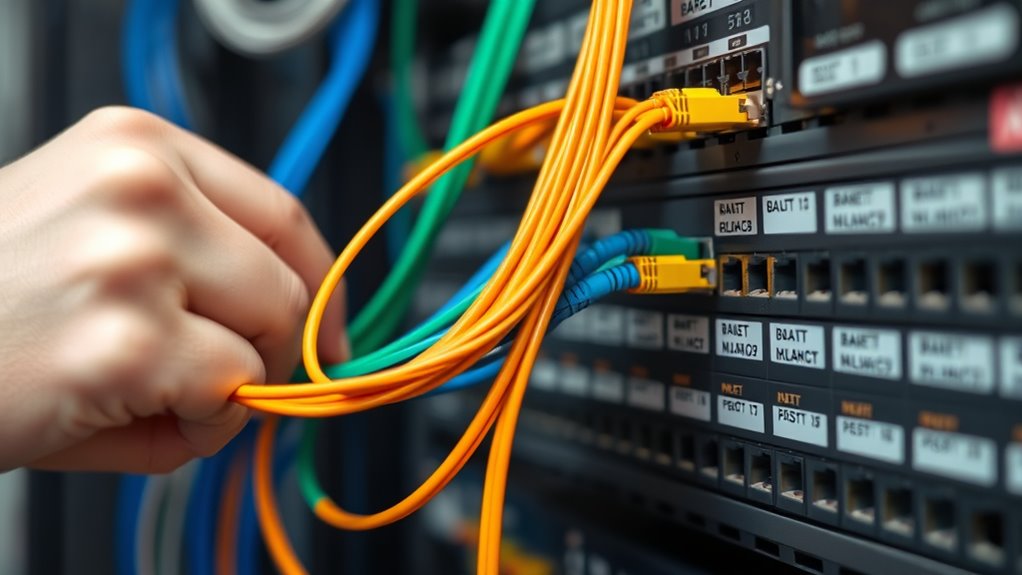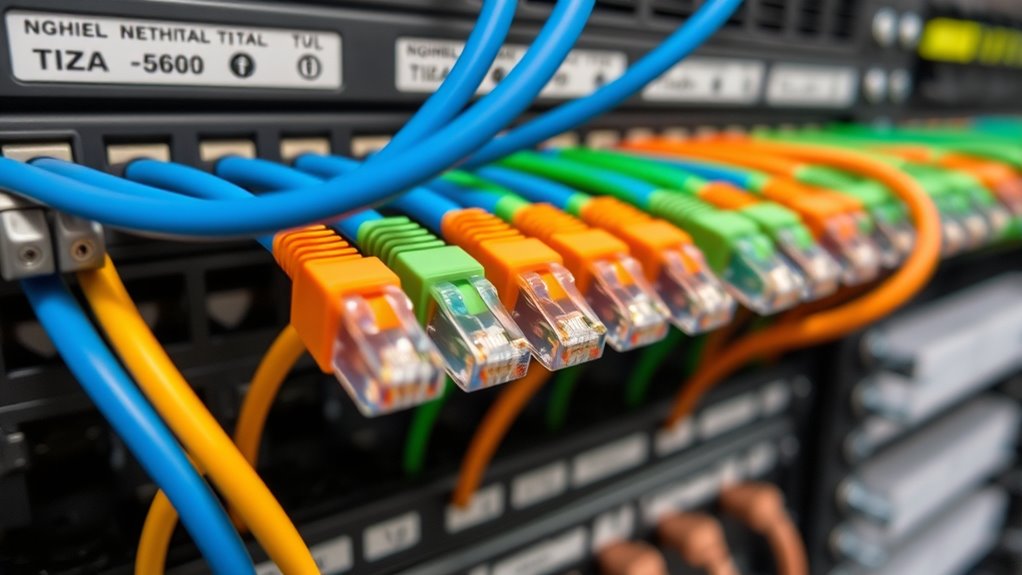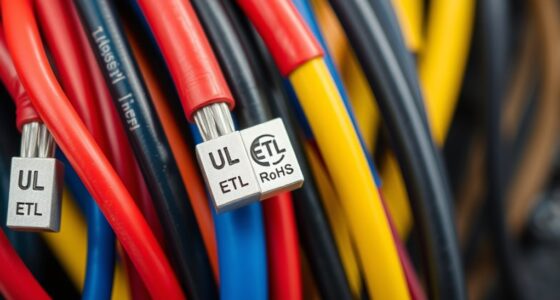TIA/EIA‑568 is a set of standards that guides how you install and organize network cabling to guarantee reliable and high-performance connections. It specifies wiring configurations, connector types, and installation practices to minimize issues like signal loss and interference. By following these standards, you help optimize your network’s speed, scalability, and stability. Understanding these guidelines helps you build a more efficient infrastructure, and exploring further will reveal how these standards can benefit your specific setup.
Key Takeaways
- TIA/EIA‑568 is a set of industry standards for telecommunications cabling and wiring configurations.
- It specifies proper installation practices to ensure network reliability, performance, and scalability.
- The standards define wiring schemes, connector types, and twisting of pairs for high data transmission quality.
- Compliance with TIA/EIA‑568 supports minimizing signal interference, noise, and network errors.
- Following these standards helps ensure consistent, reliable, and future-proof cabling infrastructure.

Have you ever wondered how network cables guarantee reliable and consistent connectivity? It all comes down to standards that guarantee your wiring meets specific quality and performance benchmarks. One of the most important frameworks for this is TIA/EIA‑568, a set of telecommunications standards developed by the Telecommunications Industry Association and the Electronic Industries Alliance. These standards specify how to properly install and organize cabling to maximize network performance and minimize issues like signal loss or interference. When you follow TIA/EIA‑568, you’re fundamentally ensuring that your network’s backbone is solid, reliable, and scalable for future needs.
Understanding the relationship between network topology and cable performance is vital. Network topology refers to the physical or logical layout of your network—how devices are connected and arranged. The way you structure your network impacts the choice of cabling and installation practices. TIA/EIA‑568 provides guidelines for various topologies, such as star, bus, or hybrid configurations, emphasizing how each influences cable performance. For example, a star topology, commonly used in modern networks, centralizes connections through a switch or hub, reducing the risk of network failure if one cable or device drops out. This setup requires high-quality cabling that can handle the demands of multiple connections without degrading signal strength or speed.
Network topology shapes cabling choices and impacts network performance and reliability.
Cable performance is directly affected by how well your cables conform to TIA/EIA‑568 standards. These standards specify wiring configurations, connector types, twisting of pairs, and shielding requirements to optimize data transmission. Proper adherence ensures cables are capable of supporting high data rates, such as gigabit Ethernet, while minimizing noise and crosstalk. When cables are installed according to standards, you get better signal integrity, reduced transmission errors, and more consistent network speeds. Conversely, ignoring these standards can lead to issues like increased latency, frequent disconnections, or slow data transfer, which frustrates users and hampers productivity.
Moreover, TIA/EIA‑568 helps you select the right type of cable—whether twisted pair, fiber optic, or coaxial—for your specific setup. It provides specifications for cable length limits, shielding, and connectors, all of which influence overall cable performance. By following these guidelines, you guarantee your network remains scalable and adaptable as your needs grow. Proper cabling based on TIA/EIA‑568 standards also simplifies troubleshooting and future upgrades, saving you time and money. Additionally, understanding cabling standards can help ensure compliance with industry regulations and safety requirements, further protecting your network infrastructure.
Frequently Asked Questions
How Often Should Cabling Standards Be Updated?
You should update cabling standards regularly, typically every 3 to 5 years, to keep pace with technological advances. During the cabling lifecycle, standards renewal is essential to guarantee your infrastructure remains reliable and efficient. Regular updates help you address new requirements, improve performance, and maintain compliance. Staying proactive in standards renewal minimizes risks and maximizes the longevity and effectiveness of your cabling system.
Are Tia/Eia‑568 Standards Compatible With International Cabling Systems?
You’ll find that TIA/EIA-568 standards are primarily designed for North American cabling systems, so their international compatibility is limited. However, they align with some global standards, making them somewhat adaptable in international projects. When working across borders, it’s essential to verify compatibility with local standards and regulations to guarantee your cabling meets international requirements and functions smoothly worldwide.
What Are Common Mistakes in Implementing Tia/Eia‑568?
You might make common mistakes like connector issues, which cause signal loss or interference, or improper grounding, risking damage and data corruption. Always double-check connector connections to make certain they’re secure and correctly aligned. Additionally, verify grounding is properly implemented to prevent electrical problems. These mistakes can compromise your cabling system’s performance, so take your time during installation, follow standards closely, and test thoroughly to avoid costly errors.
How Do Standards Impact Network Performance and Reliability?
Standards act as the backbone of your network, ensuring it runs smoothly like a well-oiled machine. By adhering to TIA/EIA‑568, you maintain signal integrity, which directly boosts performance and reduces downtime. This consistency makes troubleshooting techniques easier, allowing you to identify issues quickly and efficiently. Ultimately, following these standards creates a reliable network foundation, so your data flows seamlessly without hiccups or interruptions.
Can Existing Cabling Be Upgraded to Meet Tia/Eia‑568 Standards?
Yes, you can upgrade your existing cabling to meet TIA/EIA‑568 standards. Cabling upgrades involve replacing or re-terminating older cables to guarantee standard compliance, which improves network performance and reliability. It’s essential to evaluate your current setup, identify non-compliant components, and plan for proper upgrades. By doing so, you ensure your cabling infrastructure aligns with industry standards, reducing issues and supporting future scalability.
Conclusion
Remember, knowing TIA/EIA‑568 standards helps you build reliable networks and avoid future headaches. By following these guidelines, you guarantee quality, safety, and efficiency in your cabling projects. Think of it this way: a stitch in time saves nine. Investing a little effort now secures smoother operations later, so don’t overlook the importance of standards—they’re the foundation of a strong, lasting network. Stay informed and keep your connections solid.






